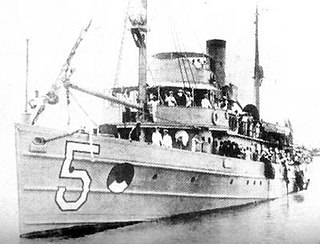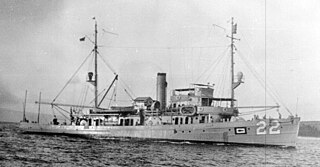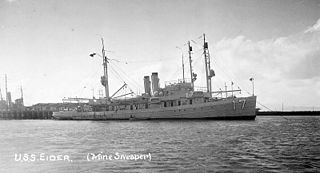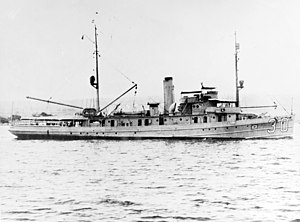
USS Redstart (AM-378/MSF-378) was an Auk-class minesweeper commissioned by the United States Navy for service in World War II. Her task, as a fleet minesweeper, was to clear mines as the fleet proceeded into battle areas.

USS Towhee (AM-388) was an Auk-class minesweeper acquired by the United States Navy for the dangerous task of removing mines from minefields laid in the water to prevent ships from passing.
USS Token (AM-126) was an Auk-class minesweeper acquired by the United States Navy for the dangerous task of removing mines from minefields laid in the water to prevent ships from passing.

USS Tanager (AM-5) was an Lapwing-class minesweeper acquired by the U.S. Navy for the task of removing mines from minefields laid in the water to prevent ships from passing.

USS Oriole (AM-7) was a Lapwing-class minesweeper acquired by the U.S. Navy for the dangerous task of removing mines from minefields laid in the water to prevent ships from passing.

USS Turkey (AM-13) was a Lapwing-class minesweeper the United States Navy, thus named after the bird, not after the country which in 1917 was an enemy in the ongoing World War I. The minesweeper was acquired by for the dangerous task of removing mines from minefields laid in the water to prevent ships from passing.

USS Thrush (AM-18) was a Lapwing-class minesweeper acquired by the United States Navy for the dangerous task of removing mines from minefields laid in the water to prevent ships from passing.

The first USS Lark (AM-21) was a Lapwing-class minesweeper in the United States Navy. She was named for the lark.

USS Widgeon (AM-22/ASR-1) was an Lapwing-class minesweeper acquired by the United States Navy for the dangerous task of removing mines from minefields laid in the water to prevent ships from passing. Later converted to a submarine rescue ship. Widgeon was named by the Navy after the widgeon, a freshwater duck.

USS Pelican (AM-27/AVP-6) was an Lapwing-class minesweeper acquired by the United States Navy for the dangerous task of removing mines from minefields laid in the water to prevent ships from passing.

The second USS Tern (AM-31) was an Lapwing-class minesweeper acquired by the U.S. Navy for the dangerous task of removing mines from minefields laid in the water to prevent ships from passing.

The first USS Swan (AM-34/AVP-7) was a Lapwing-class minesweeper acquired by the United States Navy.
USS Sanderling (AM-37) was an Lapwing-class minesweeper acquired by the United States Navy for the dangerous task of removing mines from minefields laid in the water to prevent ships from passing.

USS Kingfisher (AM-25/AT-135/ATO-135) was an Lapwing-class minesweeper acquired by the U.S. Navy for the dangerous task of removing mines from minefields laid in the water to prevent ships from passing.

USS Grebe (AM-43) was a Lapwing-class minesweeper in the United States Navy.

USS Eider (AM-17) was a Lapwing-class minesweeper of the United States Navy.

USS Sandpiper (AM-51) was a Lapwing-class minesweeper. Laid down on 15 November 1918 at the Philadelphia Navy Yard, Philadelphia, Pennsylvania, and launched on 28 April 1919, USS Sandpiper was commissioned on 9 October 1919, redesignated AM-51 on 17 February 1920, and reclassified as a Small Seaplane Tender, AVP-9 on 22 January 1936.
USS Spectacle (AM-305) was a steel-hulled Admirable class minesweeper built for the U.S. Navy during World War II. A trained crew boarded the new vessel, practiced with her minesweeping gear, and then proceeded to the Pacific Ocean to clear mines from Japanese beaches so that Allied forces could invade. While performing this dangerous task of mine clearance, a Japanese plane strafed her, and another deliberately crashed into her. When she returned to the United States, her battle damage was so severe that the U.S. Navy decided to scrap, rather than to repair, her. She was awarded two battle stars.

USS Vireo (AM-52) was a U.S. Navy Lapwing-class minesweeper, No. 52, reclassified on 1 June 1942 as a fleet tug. The bulk of her combat career was served in this capacity.

USS Auk (AM-38) was a Lapwing-class minesweeper acquired by the United States Navy after World War I to remove mines that had been placed during the war.

















